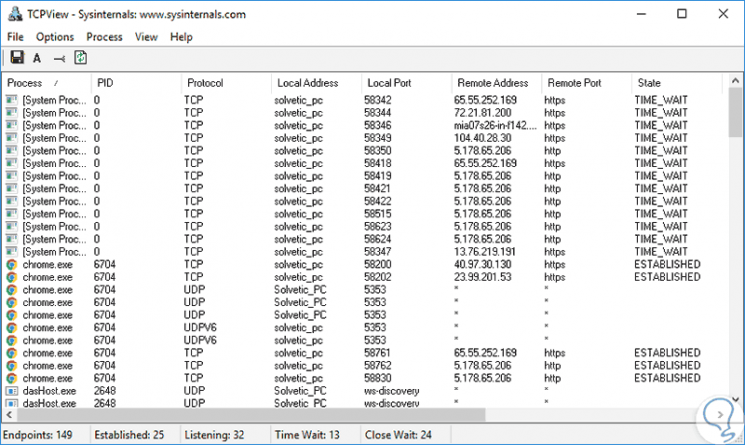

PsExec, my favorite tool of all Sysinternal tool, also got an update that mitigates named pipe squatting attacks that can be leveraged by an attacker to intercept credentials or elevate to System privilege.įor a very long time, I wasn’t able to run the PsExec tool on my work computer that has Sophos AntiVirus installed. Not to mention that it also now has a new theme with dark mode.

Windows tcpview windows#
The latest release adds a number of features like flexible filtering, searching, and shows the Windows service that owns an endpoint. Not like many other Sysinternal tools that are command lines, TCPView has a GUI that provides more informative data than what Netstate provides.įor each of the processes listed in the tool, you can right-click on it to find out the properties of that process and to kill or disconnect that process as well. Is This Article helpful ? Do you want to know more windows tools or Linux tools, Please mention in the comment box below.TCPView, the Sysinternal tool that will show you a detailed listing of all TCP and UDP endpoints on your system, including the local and remote addresses and state of TCP connections.
Windows tcpview download#
So we have tried to explain what TCPView tool is doing and how helpful it is, And also we have provided Download link for TCP View on which operating system it will support with parameters and descriptions. Server: Windows Server 2012 and higher.Parameter Description -a Show all endpoints (default is to show established TCP connections). Tcpvcon usage is similar to that of the built-in Windows netstat utility: Tcpvcon usage is similar to that of the built-in Windows netstat utility: (The TCPView download includes Tcpvcon, a command-line version with the same functionality.) Using Tcpvcon.You can save TCPView’s output window to a file using the Save menu item.You can close established TCP/IP connections (those labeled with a state of ESTABLISHED) by selecting File|Close Connections, or by right-clicking on a connection and choosing Close Connections from the resulting context menu.Endpoints that change state from one update to the next are highlighted in yellow those that are deleted are shown in red, and new endpoints are shown in green.By default, TCPView updates every second, but you can use the Options|Refresh Rate menu item to change the rate.On Windows XP systems, TCPView shows the name of the process that owns each endpoint. You can use a toolbar button or menu item to toggle the display of resolved names.



 0 kommentar(er)
0 kommentar(er)
